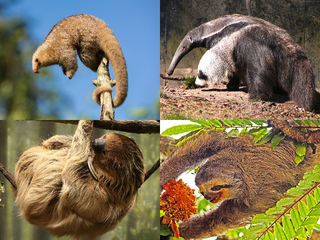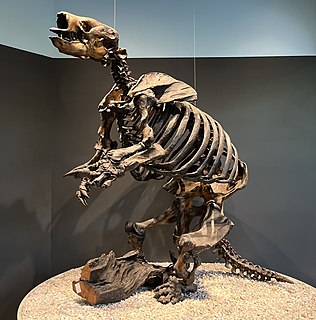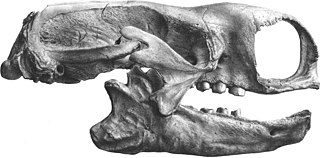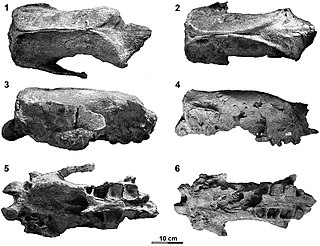
Mylodontidae is a family of extinct South American and North American ground sloths within the suborder Folivora of order Pilosa, living from around 23 million years ago (Mya) to 11,000 years ago. This family is most closely related to another family of extinct ground sloths, Scelidotheriidae, as well as to the extant arboreal two-toed sloths, family Choloepodidae; together these make up the superfamily Mylodontoidea. Phylogenetic analyses based on morphology uncovered the relationship between Mylodontidae and Scelidotheriidae; in fact, the latter was for a time considered a subfamily of mylodontids. However, molecular sequence comparisons were needed for the correct placement of Choloepodidae. These studies have been carried out using mitochondrial DNA sequences as well as with collagen amino acid sequences. The latter results indicate that Choloepodidae is closer to Mylodontidae than Scelidotheriidae is. The only other living sloth family, Bradypodidae, belongs to a different sloth radiation, Megatherioidea.

Scelidotheriidae is a family of extinct ground sloths within the order Pilosa, suborder Folivora and superfamily Mylodontoidea, related to the other extinct mylodontoid family, Mylodontidae, as well as to the living two-toed sloth family Choloepodidae. The only other extant family of the suborder Folivora is the distantly related Bradypodidae. Erected as the family Scelidotheriidae by Ameghino in 1889, the taxon was demoted to a subfamily by Gaudin in 1995. However, recent collagen sequence data indicates the group is less closely related to Mylodon and Lestodon than Choloepus is, and thus it has been elevated back to full family status by Presslee et al. (2019).

Scelidotherium is an extinct genus of ground sloth of the family Scelidotheriidae, endemic to South America during the Late Pleistocene epoch. It lived from 780,000 to 11,000 years ago, existing for approximately 0.67 million years.

The order Pilosa is a clade of xenarthran placental mammals, native to the Americas. It includes the anteaters and sloths. The name comes from the Latin word for "hairy".

Glossotherium was a genus of ground sloth. It was a heavily built animal with a length of about 4 metres (13 ft) snout to tail-tip, a weight estimated at 1,000 kg (2,200 lb), and could potentially assume a slight bipedal stance.

Paramylodon is an extinct genus of ground sloth of the family Mylodontidae endemic to North America during the Pliocene through Pleistocene epochs, living from around ~4.9 Mya–11,000 years ago. It is also known as Harlan's ground sloth.

Octodontotherium is an extinct genus of ground sloth of the family Mylodontidae, endemic to South America during the Oligocene-Early Miocene (Deseadan). It lived from 29 to 21 mya, existing for approximately 8 million years.

Mylodontinae is a subfamily of the Mylodontidae, an extinct family of ground sloths that lived from the Middle Miocene to the Early Holocene epochs.
Lestobradys is an extinct genus of ground sloth, which existed in Uruguay during the Late Miocene period; Huayquerian in the South American land mammal age (SALMA). The type species is L. sprechmanni, found in the Camacho Formation of Uruguay.
Ahytherium is an extinct genus of megalonychid sloth that lived during the Pleistocene of what is now Brazil. It contains a single species, A. aureum.

Nothrotheriidae is a family of extinct ground sloths that lived from approximately 11.6 mya—11,000 years ago, existing for approximately 11.49 million years. Previously placed within the tribe Nothrotheriini or subfamily Nothrotheriinae within Megatheriidae, they are now usually placed in their own family, Nothrotheriidae. Nothrotheriids appeared in the Tortonian, some 11.6 million years ago, in South America. The group includes the comparatively slightly built Nothrotheriops, which reached a length of about 2.75 metres (9.0 ft). While nothrotheriids were small compared to some of their megatheriid relatives, their claws provided an effective defense against predators, like those of larger anteaters today.

Nematherium is an extinct genus of ground sloth of the family Scelidotheriidae found in Argentina and Chile during the Middle Miocene epoch (Santacrucian). Fossils have been found in the Cura-Mallín Formation of Chile and the Santa Cruz and Sarmiento Formations of Argentina.
Pseudoprepotherium is an extinct genus of sloths in the family Mylodontidae. It was widespread across northern South America during the Middle and Upper Miocene around 21 to 5.3 million years ago. Fossil finds are known mostly from Venezuela and Peru. They came out of deposits that had a tropical climate with a water-rich environment. The remains are limited to limb bones, with the exception of a few skulls and teeth. Based on this, a medium-sized to large representative of the mylodonts can be concluded. The genus was scientifically named in 1961. Three species are known today, which were originally assigned to different genera.
Megathericulus is an extinct genus of ground sloths in the Megatheriidae family. It lived during the Middle Miocene around 16 to 11 million years ago of what is now South America. Fossils have been found from Argentina Bolivia and Peru, among others. It is a smaller representative of the megatheres, which, due to its dentition structure, is associated with homodont teeth belonging to the more modern line of development within the family. Because of its age, it is one of the earliest-known members of the family. The genus was scientifically named in 1904. Only one species is currently recognized, Megathericulus patagonicus.

Proeremotherium is an extinct genus of megatheriine ground sloths in the family Megatheriidae. It lived during the Late Miocene and Early Pliocene of what is now Venezuela. So far, two largely complete skulls have been recovered in the Falcón Basin in Venezuela. The finds identify the animals as medium-sized representatives of the Megatheriidae. In the cranial anatomy, Proeremotherium resembles the later and giant Eremotherium. It is therefore assumed that the two ground sloths are directly related to each other.
Archaeomylodon is an extinct genus of mylodontine ground sloths that lived during the Middle Pleistocene of what is now Argentina. It is known so far only from a single skull, which in its dimensions corresponds to those of the giant Lestodon. However, the skull differs from this one by its narrower and higher snout. In addition, the anterior canine teeth, which are usually large in many mylodonts, are greatly reduced. The find comes from the Pampa region of South America and was deposited in about 700,000 years old sediments.
Baraguatherium is an extinct genus of ground sloths of the family Mylodontidae that lived during the Early Miocene of what is now Venezuela. It dates to the Early Miocene, around 20.44 to 15.97 million years ago and represents the oldest representative of its family in the northern part of South America to date. The structure of the teeth suggests that the genus represents a rather basal form within the Mylodontidae. Unlike other mylodonts, which tended to prefer open grasslands, Baraguatherium lived in a riverine, coastal tropical rainforest.
Simomylodon is an extinct genus of ground sloths from the family Mylodontidae. It lived from the Late Miocene to the Middle Pliocene of what is now Bolivia and Argentina, 5.3 to 2.8 million years ago. The most important find material comes from the central Altiplano in Bolivia and includes several skulls and dentition remains. Thus, the so far documented body skeleton is the best known and most significant of a Miocene representative of the Mylodontidae. On the basis of the remains it can be concluded that it is a rather small member of the Mylodontidae. Within the skull material a robust and graceful form can be distinguished, which are probably associated with male and female animals. The in detail partly different skull characteristics allow conclusions on deviating behaviors. The construction of the limbs supports ground-dwelling locomotion, but this does not exclude occasional digging or climbing. The type and only known species is Simomylodon uccasamamensis.
Lakukullus is an extinct genus of nothrotheriid ground sloths that lived during the Middle Miocene around 13.8 to 11.8 million years ago of what is now Bolivia. It was a massively sized nothrotheriid, similar to Thalassocnus in size.
Prepoplanops is an extinct genus of ground sloth of the family Megatheriidae. It lived in the Miocene around 18 to 16 million years ago of what is now Argentina. The only known species is Prepoplanops boleadorensis.











